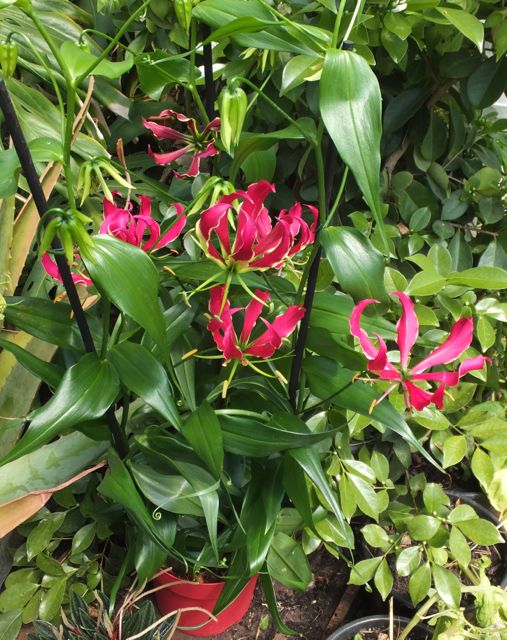 Okay, many greenhouse flowers are described as ‘exotic’, ‘stunning’, ‘impressive’, etcetera but the Glory Lily truly deserves every superlative. Except that is for ‘robust’ and ‘enduring’ as I must admit I have lost several. Still these are so exotic, stunning and impressive it is always well worth getting another.
Okay, many greenhouse flowers are described as ‘exotic’, ‘stunning’, ‘impressive’, etcetera but the Glory Lily truly deserves every superlative. Except that is for ‘robust’ and ‘enduring’ as I must admit I have lost several. Still these are so exotic, stunning and impressive it is always well worth getting another.
Glory lilies are often sold in florists as cut flowers though once removed from the plant they do not last very long. Even so they make fantastic centrepieces for bouquets and posies. With your own plants you can cut flowers for many weeks. It is wise to deadhead anyway as if they set they will make pods with red berries and few more blooms.
Gloriosa rothschildiana and the similar Gloriosa superba are species of a small genus of perennial tuberous rooted twining climbers from the lily family originally growing wild in Central and West Africa and the Indian subcontinent. Thus to keep them happy you need a permanently warm well-ventilated conservatory or hothouse. Although eventually (well in theory) getting quite large younger smaller specimens in pots can be brought into the home for decoration but will soon find it too dark and sulk.
You could grow this from seed, however other than lychees and papayas, I have seldom known seedlings and young plants so willing to give up the ghost with little apparent cause. Yet it is not difficult to keep larger plants going. They do need good canes and some training but cling themselves on with grasping tendrils.
They need warm bright conditions to do well and do not like tap water or heavy compost doing best in a mixture of sharp sand and leaf-mould kept moist with warmed rainwater. During the growing season liquid feed lightly with every watering and foliar feed sprays of dilute seaweed solution monthly. The air must never be humid in autumn and winter when the sunlight is diminished or mould will creep in.
Collectors with a hothouse could have several other beautiful species. G. rothschildiana is by far the commonest seen, and indeed perhaps the most impressive. G. verschuuri is slightly more compact with broader leaves and  fleshier crimson yellow edged blooms. G. superba from India flowers in late summer and autumn with smaller blooms with crimped peals that start green and go through yellow to orangey red as they mature. The sub-variety G. superba lutea has petals that stay all yellow. G. simplex has yellow to orange blooms in summer and is slightly more compact. G. carsonii has thinner leaves and magnificent flowers of wine purple edged with yellow.
fleshier crimson yellow edged blooms. G. superba from India flowers in late summer and autumn with smaller blooms with crimped peals that start green and go through yellow to orangey red as they mature. The sub-variety G. superba lutea has petals that stay all yellow. G. simplex has yellow to orange blooms in summer and is slightly more compact. G. carsonii has thinner leaves and magnificent flowers of wine purple edged with yellow.
I must warn you their tubers, and seeds and probably the whole plant, are poisonous and accidental ingestion in mistake for yam tubers has killed people in the past.


